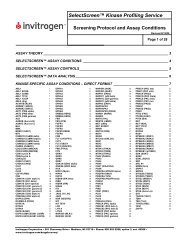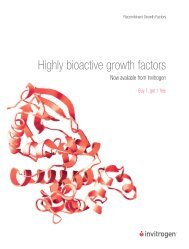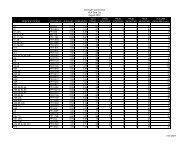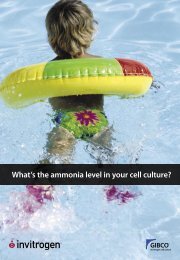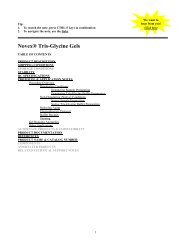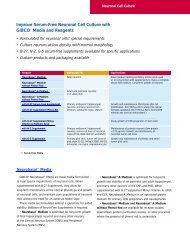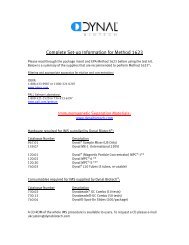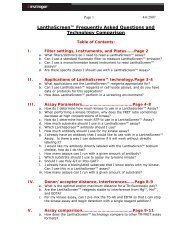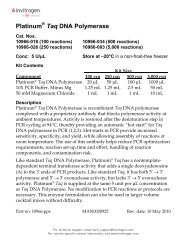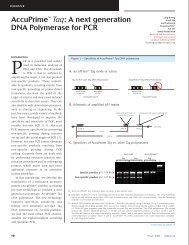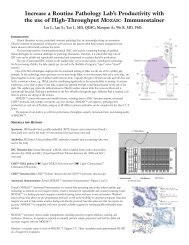TRIzol Reagent - Invitrogen
TRIzol Reagent - Invitrogen
TRIzol Reagent - Invitrogen
You also want an ePaper? Increase the reach of your titles
YUMPU automatically turns print PDFs into web optimized ePapers that Google loves.
(back to Protocol and Application Notes)<br />
(back to Protein Isolation with <strong>TRIzol</strong>)<br />
Precipitate proteins from the phenol/ethanol supernatant (from DNA isolation procedure) by adding 1.5 ml isopropanol per 1 ml of<br />
<strong>TRIzol</strong> reagent used for initial homogenization. Store sample at room temperature for 10 min. and sediment by centrifugation at<br />
12000 x g for 10 min. at 4°C.<br />
Using acetone instead of isopropanol: Proteins can be precipitated by the addition of isopropanol or acetone.<br />
Optimal protein yield can be achieved with acetone to phenol-ethanol ratios between 3:1 and 6:1 worked best (see<br />
Focus 17:3, 98).<br />
Possible stopping point: After precipitation of DNA, the protein-containing phenol/ethanol phase may be stored at -<br />
70°C for several months before proteins are isolated.<br />
Protein Wash<br />
(back to Table of Contents)<br />
(back to Protocol and Application Notes)<br />
(back to Protein Isolation with <strong>TRIzol</strong>)<br />
Remove supernatant and wash pellet 3x in 0.3 M guanidine hydrochloride (GuHCl) in 95% ethanol. Add 2 ml wash solution per 1<br />
ml <strong>TRIzol</strong> used. In general, the pellet will not be completely dispersed, as it is a very hard and rubbery pellet. Try to break up the<br />
pellet by using a pipet tip or by vortexing. During each wash cycle, store the protein pellet in wash solution for 20 min at room<br />
temperature. Centrifuge 7500 x g for 5 min. at 4°C to re-acquire pellet. After the final wash, vortex protein pellet in 2 ml 100%<br />
ethanol. Store protein pellet in ethanol for 20 min. at room temperature (this is a continuing wash to remove phenol and dye) and<br />
then centrifuge at 7500 x g for 5 min. at 4°C.<br />
Preparing 0.3M GuHCl in 95% ethanol: 6 M GuHCl (in water) can be diluted to 0.3M with absolute ethanol . .<br />
Possible stopping point: The protein pellet suspended in 0.3 M GuHCl-95% ethanol or in ethanol may be stored for<br />
at least one month at 4°C or at least one year at -20°C. There was no significant difference between proteins that<br />
were freshly prepared or stored in the phenol ethanol solution at room temperature for 1 week, at 4°C for 1 month, or<br />
at -20°C for 3 months (see Focus 17:3, 98).<br />
Alternative for guanidine hydrochloride: Guanidine thiocyanate at 0.2 M in 95% ethanol may be substituted for<br />
0.3 M GuHCl in 95% ethanol for the protein wash steps.<br />
Redissolving the Protein Pellet<br />
(back to Table of Contents)<br />
(back to Protocol and Application Notes)<br />
(back to Protein Isolation with <strong>TRIzol</strong>)<br />
The critical step in protein isolation is extraction of proteins from the pellet at the end of the protocol. The following 3 methods are<br />
alternative approaches allowing efficient recovery of proteins. Different classes of proteins, especially membrane proteins, may<br />
display different solubilities and may require different solutions or approaches.<br />
Remove the ethanol wash and air dry pellet for 5-10 min. at room temperature. Dissolve in 1% SDS by pipetting.<br />
Start by resuspending pellet in 5x volume of the pellet itself. Incubation of samples at 50°C may be required to<br />
efficiently extract soluble proteins from the pellet. The pellet is composed of soluble proteins and insoluble material<br />
such as tissue membranes, ECM, etc. Sediment insoluble material by centrifugation at 10000 x g for 10 min. at 4°C<br />
and transfer the supernatant to a clean tube. Use the protein solution immediately for Western blotting or store at -<br />
20°C.<br />
Remove the ethanol wash and air dry the protein pellet for 5-10 min. at room temperature. Dissolve the protein in 10<br />
M urea/50 mM DTT. (Prepare fresh urea/DTT each time). Add around 50 µl of solution at a time and break up the<br />
pellet using a needle. The total volume of solution added should be varied to obtain the desired concentration of<br />
solubilized proteins. Store the sample for 1 hr at room temperature. Boil the sample for 3 min. and sonicate on ice<br />
using 10 short bursts. All proteins should be in solution at this time. If not, the boiling and sonication steps may be<br />
repeated up to two more times. After complete solubilization, use the protein solution for Western blotting or store at<br />
-20°C. This procedure was developed by Drs. Linda Varela and Margot Ip and reported in the following reference:<br />
(1996) Endocrinology, vol. 137, p. 4915.<br />
21



